A System Dynamics Approach for Evaluating the Synergy Degree of Social Organizations Participating in Community and Home-Based Elderly Care Services
Abstract
1. Introduction
2. Literature Review
2.1. Social Organizations Involved in Community and Home-Based Elderly Care Services
2.2. System Dynamics Approach and Its Application
3. Research Methodology
4. SD Model Development
4.1. Model Description
4.2. Causal-Loop Diagrams
- The causal-loop diagram of institutional climate (IC)
- The causal-loop diagram of cooperation mechanism (CM)
- The causal-loop diagram of information sharing (IS)
- The causal-loop diagram of supervision capability (SC)
- The causal-loop diagram of resource allocation (RA)
- The causal-loop diagram of stakeholder engagement (SE)
4.3. Stock-Flow Diagram
4.4. Model Variables and Definitions of the Final Evaluation Indicator
| Names | Functions | Descriptions | Sources |
|---|---|---|---|
| Funding subsidy | delay (favorable policy, 1, 0.3) × law and regulations × synergy degree value | The favorable policy has a delayed effect on the funding subsidy. The delay time is year 1, and initial value is 0.3, which are confirmed through the Delphi method. | The government will not make decisions to provide funding subsidies for social organizations after implementing favorable policies, which may result in a delay in the practice [98]. So, the delay function is used in the variable [99]. |
| Market competition | normal (0, 1, 0.5, 1) × synergy degree value | The market competition conforms to normal distribution where the minimum is 0, the maximum is 1, the average value is 0.5, and the variance is 1. It is confirmed by the Delphi method. | The competition In matching markets has the characteristic of random heterogeneous preferences [100], so this paper assumes that market participation of SO-CHECS follows the random normal distribution. |
| Adequate facilities | Max (0.5 + 0.23 × funding source + 0.34 × funding subsidy, 1) | The initial value of adequate faculties is 0.5 and the maximum value is 1. | The input of facilities needs funding, so this variable is affected by funding source and funding subsidy [101]. |
| Collaborative teamwork | ramp (0.025, 0, 10) × synergy degree value | The collaborative teamwork is represented by the slope function. The slope is 0.025 from year 0 to year 10. | With the development of SO-CHECS, there will be more and more collaborative teamwork in a steady trend [102], so this paper takes the slope function of RAMP [103]. |
| Trust mechanism | delay (0.8, 1, 0.3) | The trust mechanism is a delay function influenced by the fix value 0.8. The delay time is year 1, and initial value is 0.3. | There is a delay in the trust among stakeholders due to time used in mutual understanding [104], so this paper takes the delay function to describe trust mechanism [99]. |
| Information sharing value | 0.2 + ramp (0.040, 0, 10) × synergy degree value | The information sharing value is represented by the slope function. The slope is 0.025 from year 0 to year 10. The initial value is 0.2 confirmed by the Delphi method. | The value of information sharing will rise over time with the impacts of synergy degree value, so the slope function of RAMP is used [103]. |
| Changing of IC | These are obtained by deformation of the logistic function. | The basic function is from [94], which is called as logistic function. | |
| Changing of RA | |||
| Changing of SE | |||
| Changing of CM | |||
| Changing of SC | |||
| Changing of IS |
5. Model Application
5.1. Data Collection and Data Input
5.2. Simulation Results
5.3. Model Validation
6. Scenarios and Policy Analysis
6.1. Single Management Policy
- Single management policy analysis of institutional climate (IC)
- 2.
- Single management policy analysis of supervision capability (SC)
- 3.
- Single management policy analysis of information sharing (IS)
6.2. Multiple Management Policy
- 4.
- Two-management policy combinations: institutional climate (IC) and supervision capability (SC)
- 5.
- Two-management policy combinations: institutional climate (IC) and information sharing (IS)
- 6.
- Two-management policy combinations: supervision capability (SC) and information sharing (IS)
- 7.
- Three-management policy combinations: institutional climate (IC), supervision capability (SC), and information sharing (IS)
7. Conclusions
Author Contributions
Funding
Data Availability Statement
Conflicts of Interest
References
- Sumini; Sukamdi; Pangaribowo, E.H.; Keban, Y.T.; Darwin, M. Elderly Care: A Study on Community Care Services in Sleman, DIY, Indonesia. J. Aging Res. 2020, 2020, 3983290. [Google Scholar] [CrossRef] [PubMed]
- Xiao, S.; Xusheng, L.; Feng, L.; Yu, T.; Yingshi, S. Comprehensive Evaluation of Different Scale Cities’ Sustainable Development for Economy, Society, and Ecological Infrastructure in China. J. Clean. Prod. 2017, 163, S329–S337. [Google Scholar]
- Yuan, J.; Li, L.; Wang, E.; Skibniewski, M.J. Examining Sustainability Indicators of Space Management in Elderly Facilities—A Case Study in China. J. Clean. Prod. 2019, 208, 144–159. [Google Scholar] [CrossRef]
- Shao, Q.; Yuan, J.; Lin, J.; Huang, W.; Ma, J.; Ding, H. A SBM-DEA Based Performance Evaluation and Optimization for Social Organizations Participating in Community and Home-Based Elderly Care Services. PLoS ONE 2021, 16, e0248474. [Google Scholar]
- Zhou, J.; Walker, A. The Need for Community Care among Older People in China. Aging Soc. 2016, 36, 1312–1332. [Google Scholar] [CrossRef]
- Yi, J.; Lu, D.; Deng, Y. The Future of Social Elderly Care in China: From the Perspective of Service-Oriented Government. J. Serv. Sci. Manag. 2016, 9, 211. [Google Scholar] [CrossRef][Green Version]
- Onunkwor, O.F.; Al-Dubai, S.A.R.; George, P.P.; Arokiasamy, J.; Yadav, H.; Barua, A.; Shuaibu, H.O. A Cross-Sectional Study on Quality of Life among the Elderly in Non-Governmental Organizations’ Elderly Homes in Kuala Lumpur. Health Qual. Life Outcomes 2016, 14, 6. [Google Scholar] [CrossRef]
- Teets, J.C. Reforming Service Delivery in China: The Emergence of a Social Innovation Model. J. Chin. Polit. Sci. 2012, 17, 15–32. [Google Scholar] [CrossRef]
- Haken, H. Synergetics. IEEE Circuits Devices Mag. 1977, 28, 412–414. [Google Scholar]
- Zhang, J.; Yang, C.H.; Qin, X.H.; Du, W. The Comprehensive Evaluation for the Synergetic Development of Urban Traffic System Based on DEA Model; Emerald Insight: Bingle, UK, 2007. [Google Scholar]
- Qiao, J.; Wang, M.; Zhang, D.; Ding, C.; Wang, J.; Xu, D. Synergetic Development Assessment of Urban River System Landscapes. Sustainability 2017, 9, 2145. [Google Scholar] [CrossRef]
- Moczulska, M.; Seiler, B.; Stankiewicz, J. Coopetition in For-Profit and Non-Profit Organizations—Micro Level. Management 2019, 23, 2. [Google Scholar] [CrossRef]
- Mevlja, B.; Kavi, K. Impact of Stakeholders on the Development of Non-Governmental Organisations in Slovenia. Ekon. Pregl. 2019, 70, 236–258. [Google Scholar] [CrossRef]
- Pape, U.; Brandsen, T.; Pahl, J.B.; Pieliński, B.; Baturina, D.; Brookes, N.; Chaves-Ávila, R.; Kendall, J.; Matančević, J.; Petrella, F. Changing Policy Environments in Europe and the Resilience of the Third Sector. Volunt. Int. J. Volunt. Nonprofit Organ. 2019, 31, 238–249. [Google Scholar] [CrossRef]
- Nanthagopan, Y.; Williams, N.; Thompson, K. Levels and Interconnections of Project Success in Development Projects by Non-Governmental Organisations (NGOs). Int. J. Manag. Proj. Bus. 2018, 12, 487–511. [Google Scholar] [CrossRef]
- Soysa, I.B.; Jayamaha, N.P.; Grigg, N.P. Operationalising Performance Measurement Dimensions for the Australasian Nonprofit Healthcare Sector. TQM J. 2016, 28, 954–973. [Google Scholar] [CrossRef]
- Theobald, H.; Luppi, M. Elderly Care in Changing Societies: Concurrences in Divergent Care Regimes–A Comparison of Germany, Sweden and Italy. Curr. Sociol. 2018, 66, 629–642. [Google Scholar] [CrossRef]
- Pestoff, V. Co-Production and Third Sector Social Services in Europe: Some Concepts and Evidence. Volunt. Int. J. Volunt. Nonprofit Organ. 2012, 23, 1102–1118. [Google Scholar] [CrossRef]
- Osborne, S.P.; Radnor, Z.; Strokosch, K. Co-Production and the Co-Creation of Value in Public Services: A Suitable Case for Treatment? Public Manag. Rev. 2016, 18, 639–653. [Google Scholar] [CrossRef]
- Galina, Z.; Andrey, L.; Nemec, J. Arrangements for the Transfer of Social-Services Delivery to Non-Governmental Providers (Regional Practices, Russia). NISPAcee J. Public Adm. Policy 2019, 12, 251–274. [Google Scholar]
- Yalegama, S.; Chileshe, N.; Ma, T. Critical Success Factors for Community-Driven Development Projects: A Sri Lankan Community Perspective. Int. J. Proj. Manag. 2016, 34, 643–659. [Google Scholar] [CrossRef]
- Shao, Q.; Id, J.Y.; Ma, J.; Ding, H.; Huang, W. Exploring the Determinants of Synergetic Development of Social Organizations Participating in Home-Based Elderly Care Service: An SEM Method. PLoS ONE 2020, 15, e0244880. [Google Scholar] [CrossRef] [PubMed]
- Xiaohua, F. Research on the Self-Organization of Sustainable Development System in China with the View of Synergetics. J. Syst. Dialectics 2004, 1, 50–55. [Google Scholar]
- Lu, X. The Synergy of Urban Development and Transport Infrastructure: An Example of the Shanghai Hongqiao Transportation Hub. In ICCREM 2014: Smart Construction and Management in the Context of New Technology; ASCE Library: New York, NY, USA, 2014; pp. 1480–1487. [Google Scholar]
- Jiang, Y. Research on the Sustainable Development of Subway Station Based on Synergetic Theory. In Resilience and Sustainable Transportation Systems; American Society of Civil Engineers: Reston, VA, USA, 2020; pp. 648–655. [Google Scholar]
- Wu, Y.; Chen, J.; He, P. Synergetic Analysis of the Public Transit System and Urban Form for Small-and Medium-Sized Cities. In ICTE 2015; ASCE Library: New York, NY, USA, 2015; pp. 2002–2010. [Google Scholar]
- Bayer, R.B.S. Business Dynamics: Systems Thinking and Modeling for a Complex World. Interfaces 2004, 34, 324–326. [Google Scholar]
- Yuan, H.; Yang, B. System Dynamics Approach for Evaluating the Interconnection Performance of Cross-Border Transport Infrastructure. J. Manag. Eng. 2022, 38, 4022008. [Google Scholar] [CrossRef]
- Jiang, Z.; Fang, D.; Zhang, M. Understanding the Causation of Construction Workers’ Unsafe Behaviors Based on System Dynamics Modeling. J. Manag. Eng. 2015, 31, 4014099. [Google Scholar] [CrossRef]
- Khoshneshin, F.; Bastan, M. Analysis of Dynamics of Crisis Management in the Earthquake and Performance Improvement Using System Dynamics Methodology. In Proceedings of the 10th International Conference on Industrial Engineering (IIEC 2014), Tehran, Iran, 27–28 January 2014. (In Persian). [Google Scholar]
- Machowski, J.; Lubosny, Z.; Bialek, J.W.; Bumby, J.R. Power System Dynamics: Stability and Control; John Wiley & Sons: New York, NY, USA, 2020; ISBN 1119526345. [Google Scholar]
- Sterman, J.; Oliva, R.; Linderman, K.W.; Bendoly, E. System Dynamics Perspectives and Modeling Opportunities for Research in Operations Management. J. Oper. Manag. 2015, 39, 40. [Google Scholar] [CrossRef]
- John, D.S. System Dynamics Modeling: Tools for Learning in a Complex World. Calif. Manag. Rev. 2001, 43, 8–25. [Google Scholar]
- Leon, H.; Osman, H.; Georgy, M.; Elsaid, M. System Dynamics Approach for Forecasting Performance of Construction Projects. J. Manag. Eng. 2018, 34, 4017049. [Google Scholar] [CrossRef]
- Nasirzadeh, F.; Nojedehi, P. Dynamic Modeling of Labor Productivity in Construction Projects. Int. J. Proj. Manag. 2013, 31, 903–911. [Google Scholar] [CrossRef]
- Li, Z.; Li, N.; Cimellaro, G.P.; Fang, D. System Dynamics Modeling-Based Approach for Assessing Seismic Resilience of Hospitals: Methodology and a Case in China. J. Manag. Eng. 2020, 36, 4020050. [Google Scholar] [CrossRef]
- Nasir, M.K.; Hadikusumo, B.H.W. System Dynamics Model of Contractual Relationships between Owner and Contractor in Construction Projects. J. Manag. Eng. 2019, 35, 4018052. [Google Scholar] [CrossRef]
- Bastan, M.; Abdollahi, F.; Shokoufi, K. Analysis of Iran’s Dust Emission with System Dynamics Methodology. Technol. J. Eng. Appl. Sci. 2013, 3, 3515–3524. [Google Scholar]
- Ma, Q.; Wu, W.; Liu, Y.; Liang, Z.; Kou, L. Impact of the Synergy between Technology Management and Technological Capability on New Product Development: A System Dynamics Approach. J. Syst. Eng. Electron. 2022, 33, 105–119. [Google Scholar] [CrossRef]
- Yang, J.; Lei, K.; Khu, S.; Meng, W. Assessment of Water Resources Carrying Capacity for Sustainable Development Based on a System Dynamics Model: A Case Study of Tieling City, China. Water Resour. Manag. 2015, 29, 885–899. [Google Scholar] [CrossRef]
- Bastan, M.; Khorshid-Doust, R.R.; Sisi, S.D.; Ahmadvand, A. Sustainable Development of Agriculture: A System Dynamics Model. Kybernetes 2017, 47, 142–162. [Google Scholar] [CrossRef]
- Hassan, M.N.; Hawas, Y.E.; Ahmed, K. A Multi-Dimensional Framework for Evaluating the Transit Service Performance. Transp. Res. Part A Policy Pract. 2013, 50, 47–61. [Google Scholar] [CrossRef]
- Ansell, C.; Gash, A. Collaborative Governance in Theory and Practice. J. Public Adm. Res. Theory 2008, 18, 543–571. [Google Scholar] [CrossRef]
- Du, Z. A Literature Review on Institutional Environment and Technological Innovation. Am. J. Ind. Bus. Manag. 2018, 8, 1941–1950. [Google Scholar] [CrossRef]
- Peng, M.W.; Sun, S.L.; Pinkham, B.; Chen, H. The Institution-Based View as a Third Leg for a Strategy Tripod. Acad. Manag. Perspect. 2009, 23, 63–81. [Google Scholar] [CrossRef]
- Mor, V.; Zinn, J.; Angelelli, J.; Teno, J.M.; Miller, S.C. Driven to Tiers: Socioeconomic and Racial Disparities in the Quality of Nursing Home Care. Milbank Q. 2004, 82, 227–256. [Google Scholar] [CrossRef]
- Genet, N.; Boerma, W.G.W.; Kringos, D.S.; Bouman, A.; Francke, A.L.; Fagerström, C.; Melchiorre, M.G.; Greco, C.; Devillé, W. Home Care in Europe: A Systematic Literature Review. BMC Health Serv. Res. 2011, 11, 207. [Google Scholar] [CrossRef] [PubMed]
- Wang, H.-H.; Tsay, S.-F. Elderly and Long-Term Care Trends and Policy in Taiwan: Challenges and Opportunities for Health Care Professionals. Kaohsiung J. Med. Sci. 2012, 28, 465–469. [Google Scholar] [CrossRef] [PubMed]
- Roquebert, Q.; Tenand, M. Pay Less, Consume More? The Price Elasticity of Home Care for the Disabled Elderly in France. Health Econ. 2017, 26, 1162–1174. [Google Scholar] [CrossRef] [PubMed]
- Bamford, C.; Heaven, B.; May, C.; Moynihan, P. Implementing Nutrition Guidelines for Older People in Residential Care Homes: A Qualitative Study Using Normalization Process Theory. Implement. Sci. 2012, 7, 106. [Google Scholar] [CrossRef]
- Roblin, B.; Deber, R.; Kuluski, K.; Silver, M.P. Ontario’s Retirement Homes and Long-Term Care Homes: A Comparison of Care Services and Funding Regimes. Can. J. Aging/La Rev. Can. Vieil. 2019, 38, 155–167. [Google Scholar] [CrossRef]
- Forder, J.; Allan, S. The Impact of Competition on Quality and Prices in the English Care Homes Market. J. Health Econ. 2014, 34, 73–83. [Google Scholar] [CrossRef]
- Zhou, S.; Ng, S.T.; Li, D.; Zhang, J.; Fan, J.; Yang, Y. Characterizing Stakeholders of Aging-in-Place through Social Network Analysis: A Study of Nanjing, China. Sustainability 2019, 11, 6722. [Google Scholar] [CrossRef]
- Zhang, R.; Zhang, Z.; Peng, Y.; Zhai, S.; Zhou, J.; Chen, J. The Multi-Subject Cooperation Mechanism of Home Care for the Disabled Elderly in Beijing: A Qualitative Research. BMC Prim. Care 2022, 23, 186. [Google Scholar] [CrossRef]
- Jacobs, G. Patient Autonomy in Home Care: Nurses’ Relational Practices of Responsibility. Nurs. Ethics 2019, 26, 1638–1653. [Google Scholar] [CrossRef]
- Tieman, J.; Mitchell, G.; Shelby-James, T.; Currow, D.; Fazekas, B.S.; O’Doherty, L.J.; Hegarty, M.; Eriksson, L.; Brown, R.; Reid-Orr, D. Integration, Coordination and Multidisciplinary Approaches in Primary Care: A Systematic Investigation of the Literature; Australian Primary Health Care Research Institute: Canberra, ACT, Australia, 2017. [Google Scholar]
- Guan, Z.; Zhang, X.; Zhou, M.; Dan, Y. Demand Information Sharing in Competing Supply Chains with Manufacturer-Provided Service. Int. J. Prod. Econ. 2020, 220, 107450. [Google Scholar] [CrossRef]
- Osei-Frimpong, K.; Wilson, A.; Lemke, F. Patient Co-Creation Activities in Healthcare Service Delivery at the Micro Level: The Influence of Online Access to Healthcare Information. Technol. Forecast. Soc. Chang. 2018, 126, 14–27. [Google Scholar] [CrossRef]
- Kanai, H.; Kumazawa, A. An Information Sharing System for Multi-Professional Collaboration in the Community-Based Integrated Healthcare System. Int. J. Inform. Inf. Syst. Comput. Eng. 2021, 2, 1. [Google Scholar] [CrossRef]
- Shimizu, N.; Kotani, K. Health Information Exchange in Relation to Point-of-Care Testing in Home Care: Issues in Japan. Clin. Chim. Acta 2022, 532, 10–12. [Google Scholar] [CrossRef] [PubMed]
- Woodward, C.A.; Abelson, J.; Tedford, S.; Hutchison, B. What Is Important to Continuity in Home Care: Perspectives of Key Stakeholders. Soc. Sci. Med. 2004, 58, 177–192. [Google Scholar] [CrossRef]
- Yamashita, N.; Kuzuoka, H.; Kudo, T.; Hirata, K.; Aramaki, E.; Hattori, K. How Information Sharing about Care Recipients by Family Caregivers Impacts Family Communication. In Proceedings of the 2018 Chi Conference on Human Factors in Computing Systems, Montreal, QC, Canada, 21–26 April 2018; pp. 1–13. [Google Scholar]
- Levenson, S.A. The Impact of Laws and Regulations in Improving Physician Performance and Care Processes in Long-Term Care. J. Am. Med. Dir. Assoc. 2004, 5, 268–277. [Google Scholar] [CrossRef]
- Nielsen, J.A.; Mathiassen, L. Interpretive Flexibility in Mobile Health: Lessons from a Government-Sponsored Home Care Program. J. Med. Internet Res. 2013, 15, e236. [Google Scholar] [CrossRef]
- Plugaru, A.; Ponea, S. Evaluation of Supervision Practice of the Social Services Provided to Elderly in Home Care Centre. Postmod. Open. 2010, 3, 49–70. [Google Scholar]
- Liu, Y.; Zhang, L.; Yang, Y.; Zhou, L.; Ren, L.; Wang, F.; Liu, R.; Pang, Z.; Deen, M.J. A Novel Cloud-Based Framework for the Elderly Healthcare Services Using Digital Twin. IEEE Access 2019, 7, 49088–49101. [Google Scholar] [CrossRef]
- Costa, A.; Yelshyna, A.; Moreira, T.C.; Andrade, F.C.P.; Julián, V.; Novais, P. A Legal Framework for an Elderly Healthcare Platform: A Privacy and Data Protection Overview. Comput. Law Secur. Rev. 2017, 33, 647–658. [Google Scholar] [CrossRef]
- Owili, P.O.; Hsu, Y.-H.E.; Chern, J.-Y.; Chiu, C.-H.M.; Wang, B.; Huang, K.-C.; Muga, M.A. Perceptions and Attitudes of Health Professionals in Kenya on National Health Care Resource Allocation Mechanisms: A Structural Equation Modeling. PLoS ONE 2015, 10, e0127160. [Google Scholar] [CrossRef]
- Schiavone, F.; Mancini, D.; Leone, D.; Lavorato, D. Digital Business Models and Ridesharing for Value Co-Creation in Healthcare: A Multi-Stakeholder Ecosystem Analysis. Technol. Forecast. Soc. Chang. 2021, 166, 120647. [Google Scholar] [CrossRef]
- Stone, R.I.; Bryant, N.S. The Future of the Home Care Workforce: Training and Supporting Aides as Members of Home-based Care Teams. J. Am. Geriatr. Soc. 2019, 67, S444–S448. [Google Scholar] [CrossRef] [PubMed]
- Ploylearmsang, C.; Tongsiri, S.; Pirikannont, M.; Srisaknok, T. Effects of Home-Based Care Inter-Professional Education on Students’ Outcomes: Mahasarakham University Experiences. Med. Sci. Educ. 2021, 31, 677–685. [Google Scholar] [CrossRef] [PubMed]
- Ogundele, B.O.; Olafimihan, H.O. Facilities and Equipment as Predictors of Effective Health Care Delivery Services in Selected State Government Hospitals in Oyo State, Nigeria. Anthropology 2009, 11, 181–187. [Google Scholar] [CrossRef]
- Glendinning, C. Home Care in England: Markets in the Context of Under-funding. Health Soc. Care Community 2012, 20, 292–299. [Google Scholar] [CrossRef]
- Kang’ethe, S.M.; Mangwiro, V.P. Exploring the Effectiveness of Community Home-Based Care (CHBC) Programs in Africa with Examples from Some African Countries. Stud. Ethno-Med. 2015, 9, 219–226. [Google Scholar] [CrossRef]
- Mustapha, A.B.; Malah, B.J.; Daluma, M.S. Institutions and Resource Allocation Towards Understanding Economic Efficiency. Afr. J. Manag. 2017, 2, 201–202. [Google Scholar]
- Moon, T. How to Start a Home-Based Senior Care Business; Library Journal: New York, NY, USA, 2011. [Google Scholar]
- Dahan, S.; Bourque, C.J.; Reichherzer, M.; Ahmed, M.; Josée, P.; Mantha, G.; Labelle, F.; Janvier, A. Beyond a Seat at the Table: The Added Value of Family Stakeholders to Improve Care, Research, and Education in Neonatology. J. Pediatr. 2019, 207, 123–129. [Google Scholar] [CrossRef]
- Ehrenhard, M.; Kijl, B.; Nieuwenhuis, L. Market Adoption Barriers of Multi-Stakeholder Technology: Smart Homes for the Aging Population. Technol. Forecast. Soc. Chang. 2014, 89, 306–315. [Google Scholar] [CrossRef]
- Kuo, M.-H.; Wang, S.-L.; Chen, W.-T. Using Information and Mobile Technology Improved Elderly Home Care Services. Health Policy Technol. 2016, 5, 131–142. [Google Scholar] [CrossRef]
- Busetto, L.; Luijkx, K.; Vrijhoef, H.J.M. Development of the COMIC Model for the Comprehensive Evaluation of Integrated Care Interventions. Int. J. Care Coord. 2016, 19, 47–58. [Google Scholar] [CrossRef]
- Brown, H.; Green, M. At the Service of Community Development: The Professionalization of Volunteer Work in Kenya and Tanzania. Afr. Stud. Rev. 2015, 58, 63–84. [Google Scholar] [CrossRef]
- Vergados, D.D. Service Personalization for Assistive Living in a Mobile Ambient Healthcare-Networked Environment. Pers. Ubiquitous Comput. 2010, 14, 575–590. [Google Scholar] [CrossRef]
- Hartley, J.; Sørensen, E.; Torfing, J. Collaborative Innovation: A Viable Alternative to Market Competition and Organizational Entrepreneurship. Public Adm. Rev. 2013, 73, 821–830. [Google Scholar] [CrossRef]
- Snow, C.C. Organizing in the Age of Competition, Cooperation, and Collaboration. J. Leadersh. Organ. Stud. 2015, 22, 433–442. [Google Scholar] [CrossRef]
- Salas, E.; Rico, R.; Passmore, J. The Psychology of Teamwork and Collaborative Processes. In The Wiley Blackwell Handbook of the Psychology of Team Working and Collaborative Processes; Wiley: Hoboken, NJ, USA, 2017; Volume 22, pp. 433–442. [Google Scholar]
- Newhouse, R.P.; Spring, B. Interdisciplinary Evidence-Based Practice: Moving from Silos to Synergy. Nurs. Outlook 2010, 58, 309–317. [Google Scholar] [CrossRef]
- Haddad, C.R.; Ayala, D.H.F.; Maldonado, M.U.; Forcellini, F.A.; Lezana, Á.G.R. Process Improvement for Professionalizing Non-Profit Organizations: BPM Approach. Bus. Process Manag. J. 2016, 22, 634–658. [Google Scholar] [CrossRef]
- Garg, L.; McClean, S.; Meenan, B.; Millard, P. A Non-Homogeneous Discrete Time Markov Model for Admission Scheduling and Resource Planning in a Cost or Capacity Constrained Healthcare System. Health Care Manag. Sci. 2010, 13, 155–169. [Google Scholar] [CrossRef]
- Xie, J.; Shen, W. Collaborative Public Management: A Technological Solution Framework on Urban Outdoor Advertising Media Supervision in China. In Proceedings of the 2010 International Conference on Management Science & Engineering 17th Annual Conference Proceedings, Melbourne, VIC, Australia, 24–26 November 2010; IEEE: Piscataway, NY, USA, 2010; pp. 1911–1917. [Google Scholar]
- Emerson, K.; Nabatchi, T.; Balogh, S. An Integrative Framework for Collaborative Governance. J. Public Adm. Res. Theory 2012, 22, 1–29. [Google Scholar] [CrossRef]
- Kim, H.; Lee, C.W. Efficiency Analysis for Nonprofit Organizations Using DEA: Focused on Humanitarian Assistance Organizations in South Korea. Asia Pacific J. Innov. Entrep. 2018, 12, 165–180. [Google Scholar] [CrossRef]
- Binder, T.; Vox, A.; Belyazid, S.; Haraldsson, H.; Svensson, M. Developing System Dynamics Models from Causal Loop Diagrams. In Proceedings of the 22nd International Conference of the System Dynamic Society, Oxford, UK, 22–26 July 2004; pp. 1–21. [Google Scholar]
- Bala, B.K.; Arshad, F.M.; Noh, K.M. System Dynamics. In Modelling and Simulation; Springer: Singapore, 2017; pp. 1–274. [Google Scholar] [CrossRef]
- Cramer, J.S. The Origins of Logistic Regression; Tinbergen Institute: Amsterdam, The Netherlands, 2002. [Google Scholar]
- Mood, C. Logistic Regression: Why We Cannot Do What We Think We Can Do, and What We Can Do about It. Eur. Sociol. Rev. 2010, 26, 67–82. [Google Scholar] [CrossRef]
- Barry, A.; Thrift, N. Gabriel Tarde: Imitation, Invention and Economy. Econ. Soc. 2007, 36, 509–525. [Google Scholar] [CrossRef]
- Cao, H.; Folan, P. Product Life Cycle: The Evolution of a Paradigm and Literature Review from 1950–2009. Prod. Plan. Control 2012, 23, 641–662. [Google Scholar] [CrossRef]
- Akortsu, M.A.; Abor, P.A. Financing Public Healthcare Institutions in Ghana. J. Health Organ. Manag. 2011, 25, 128–141. [Google Scholar] [CrossRef] [PubMed]
- Špicar, R. System Dynamics Archetypes in Capacity Planning. Procedia Eng. 2014, 69, 1350–1355. [Google Scholar] [CrossRef]
- Ashlagi, I.; Kanoria, Y.; Leshno, J.D. Unbalanced Random Matching Markets: The Stark Effect of Competition. J. Polit. Econ. 2017, 125, 69–98. [Google Scholar] [CrossRef]
- Zhan, H.J.; Liu, G.; Guan, X.; Bai, H. Recent Developments in Institutional Elder Care in China: Changing Concepts and Attitudes. J. Aging Soc. Policy 2006, 18, 85–108. [Google Scholar] [CrossRef]
- Morley, L.; Cashell, A. Collaboration in Health Care. J. Med. Imaging Radiat. Sci. 2017, 48, 207–216. [Google Scholar] [CrossRef]
- Liu, S.; Triantis, K.P.; Sarangi, S. Representing Qualitative Variables and Their Interactions with Fuzzy Logic in System Dynamics Modeling. Syst. Res. Behav. Sci. 2011, 28, 245–263. [Google Scholar] [CrossRef]
- Jahansoozi, J. Organization-stakeholder Relationships: Exploring Trust and Transparency. J. Manag. Dev. 2006, 25, 942–955. [Google Scholar] [CrossRef]
- Barlas, Y. Multiple Tests for Validation of System Dynamics Type of Simulation Models. Eur. J. Oper. Res. 1989, 42, 59–87. [Google Scholar] [CrossRef]
- Senge, P.M.; Forrester, J.W. Tests for Building Confidence in System Dynamics Models. Syst. Dyn. TIMS Stud. Manag. Sci. 1980, 14, 209–228. [Google Scholar]
- Shao, Q. Evaluation, Optimization and Improvement Study of Synergistic Degree of Home and Community-Based Elderly Care Involving Non-Profit Organization; Southeast University: Nanjing, China, 2021. [Google Scholar]
- Xu, T.; Birchfield, A.B.; Overbye, T.J. Modeling, Tuning, and Validating System Dynamics in Synthetic Electric Grids. IEEE Trans. Power Syst. 2018, 33, 6501–6509. [Google Scholar] [CrossRef]
- Akoglu, H. User’s Guide to Correlation Coefficients. Turkish J. Emerg. Med. 2018, 18, 91–93. [Google Scholar] [CrossRef]
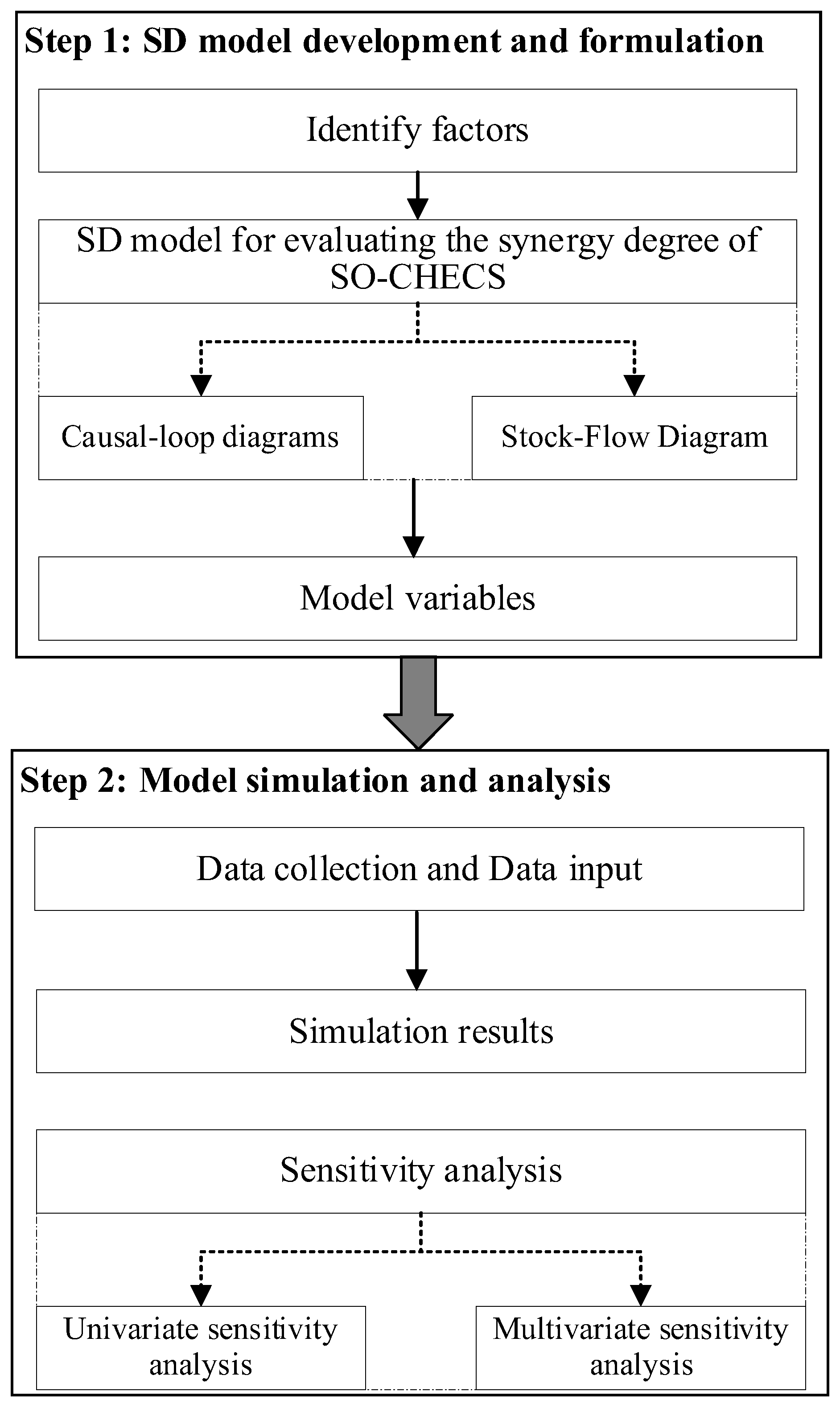
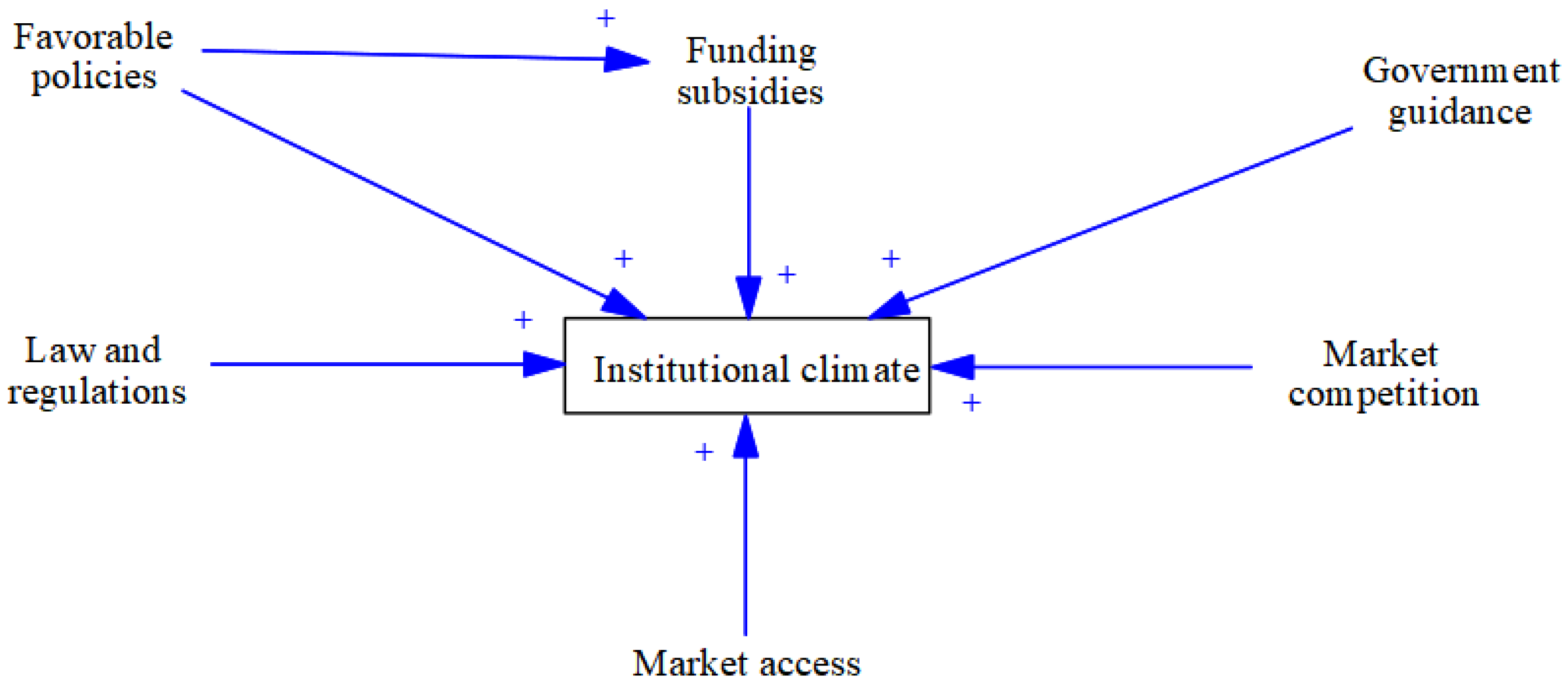


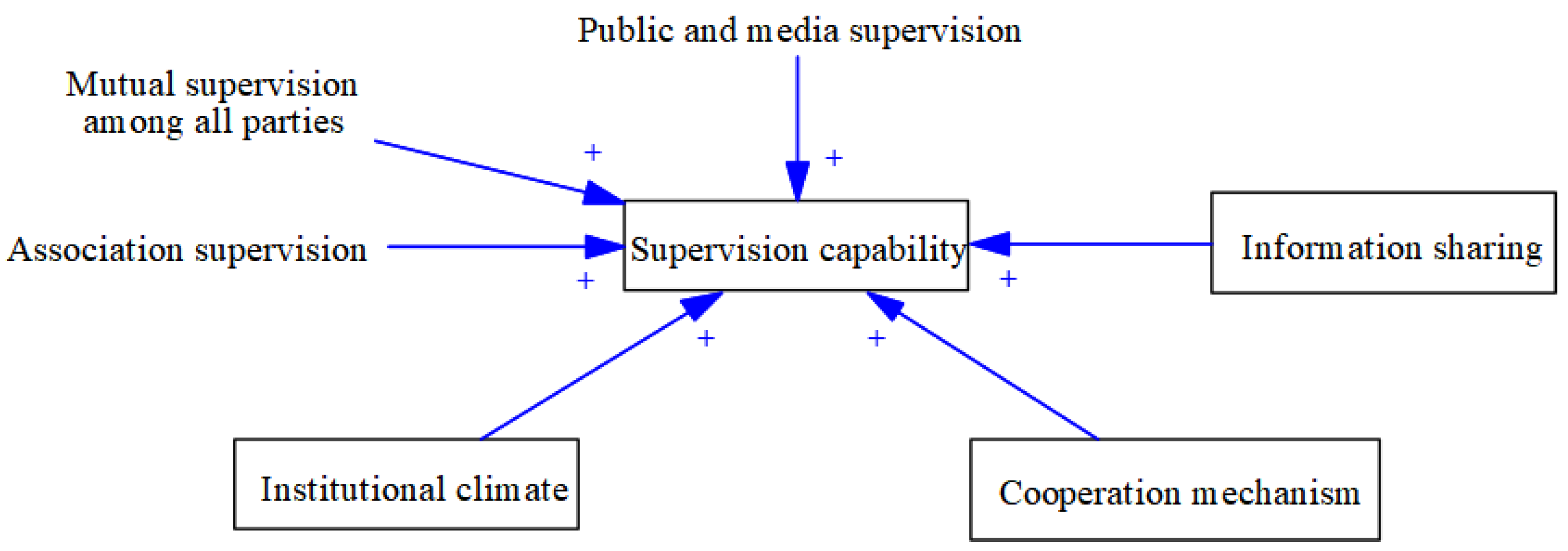
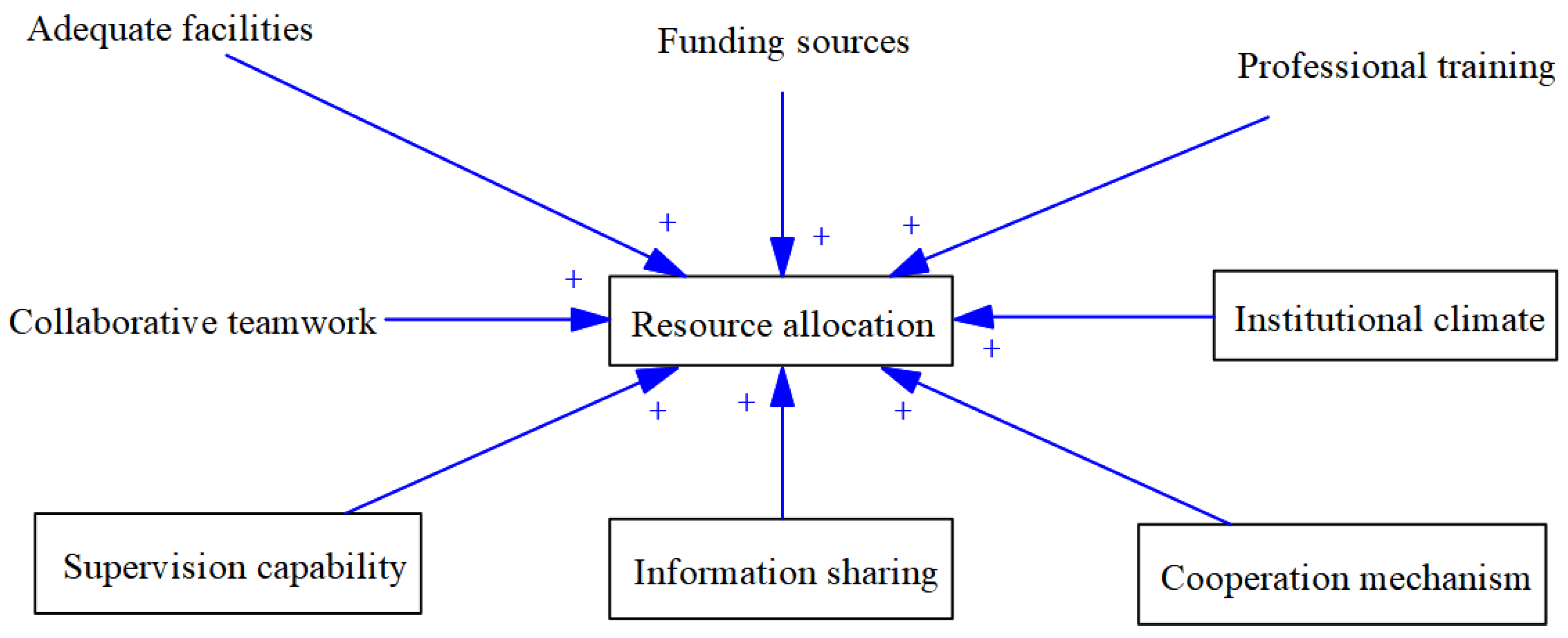
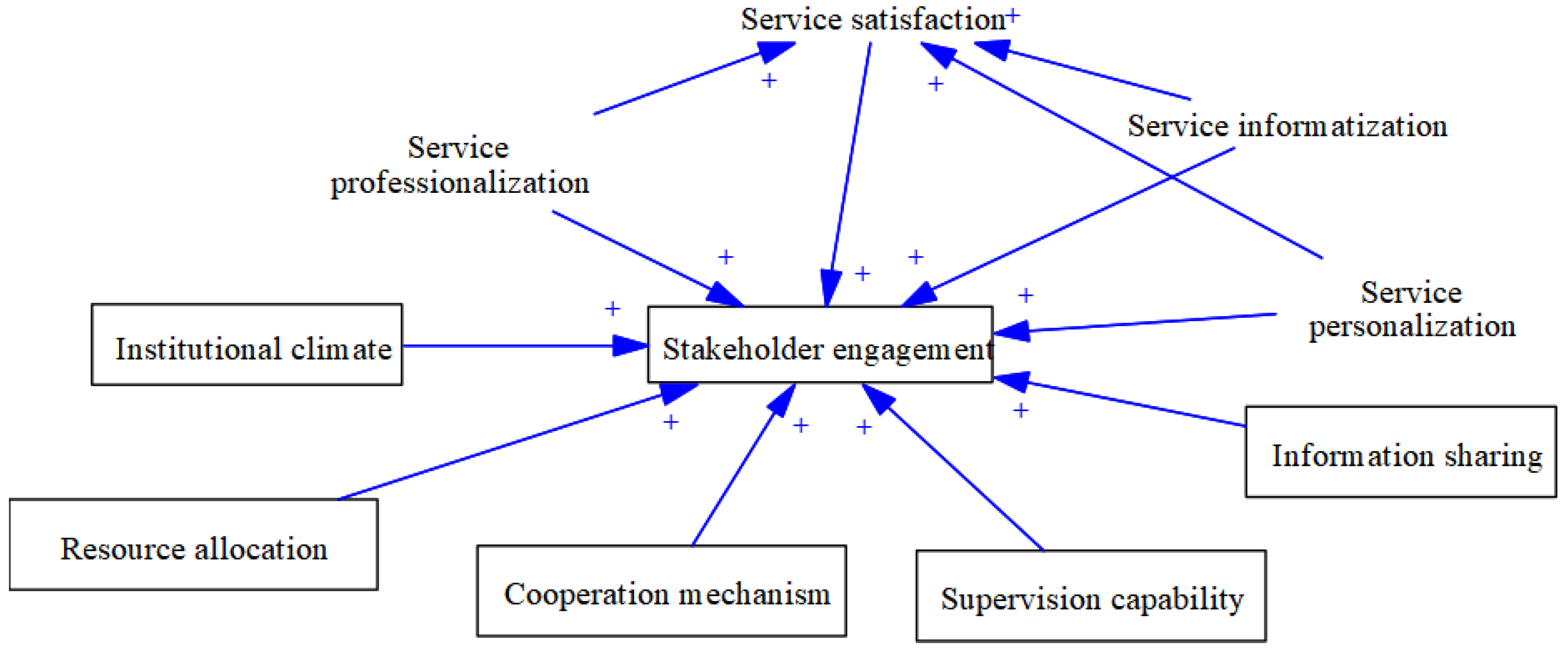

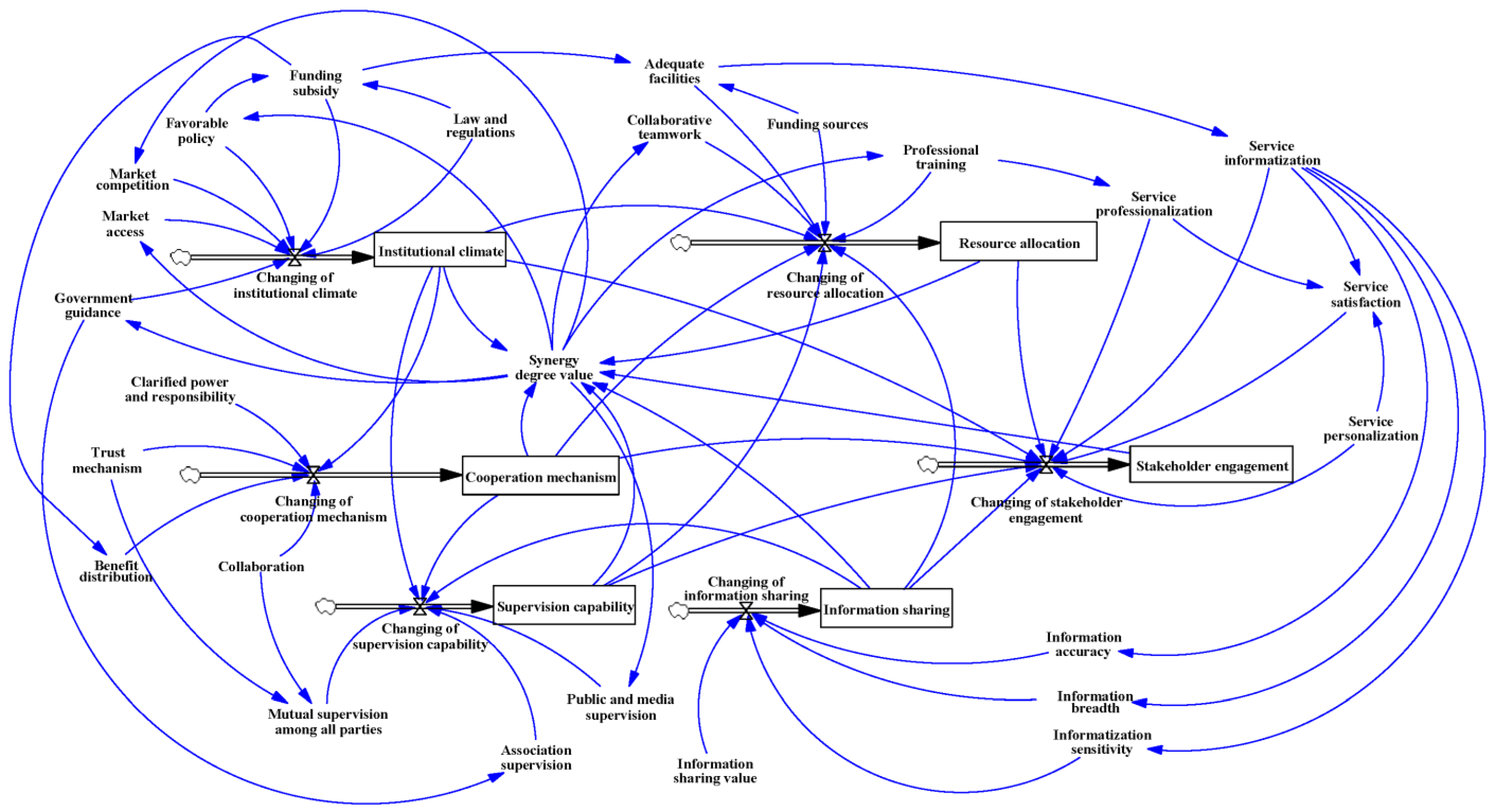
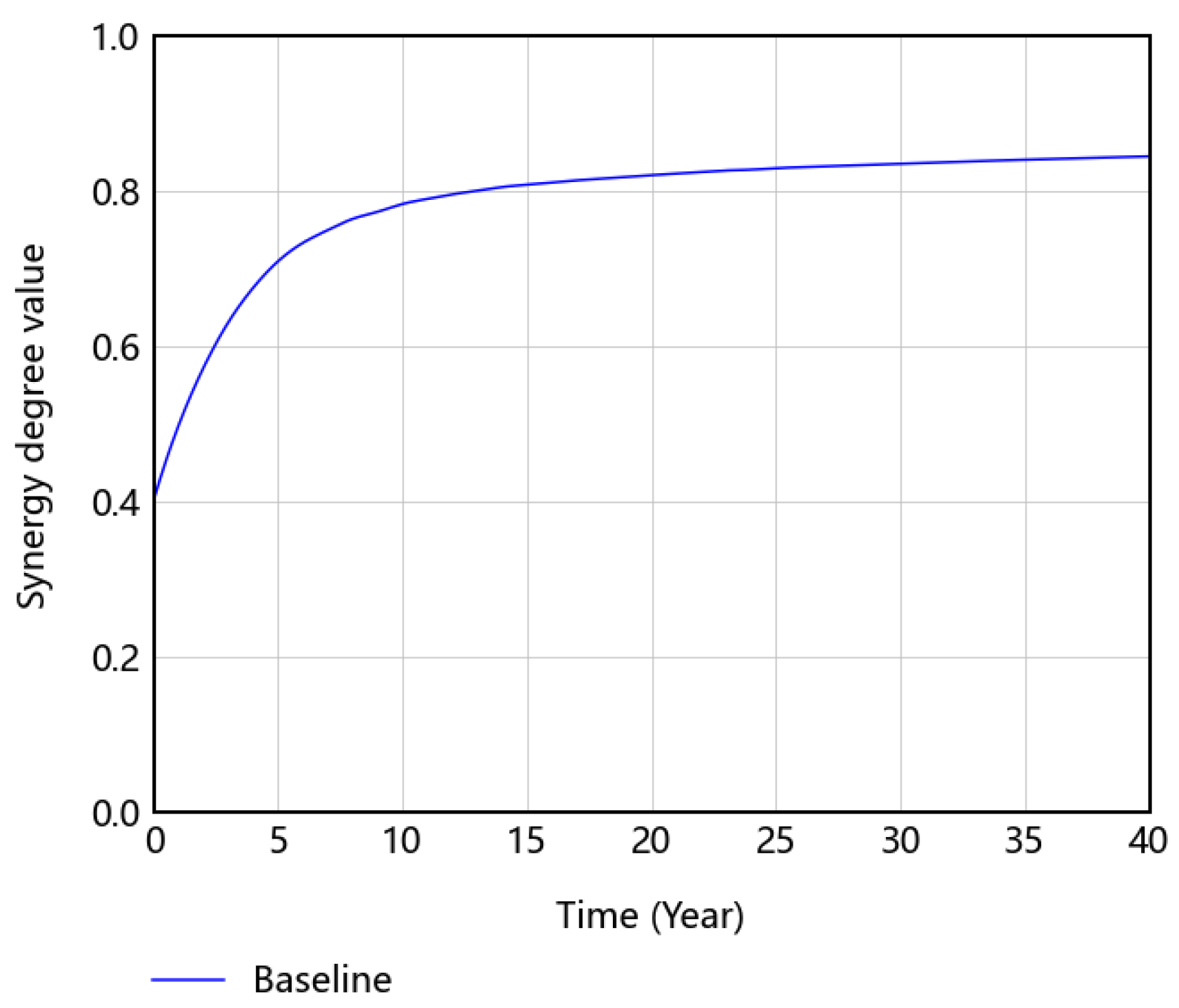

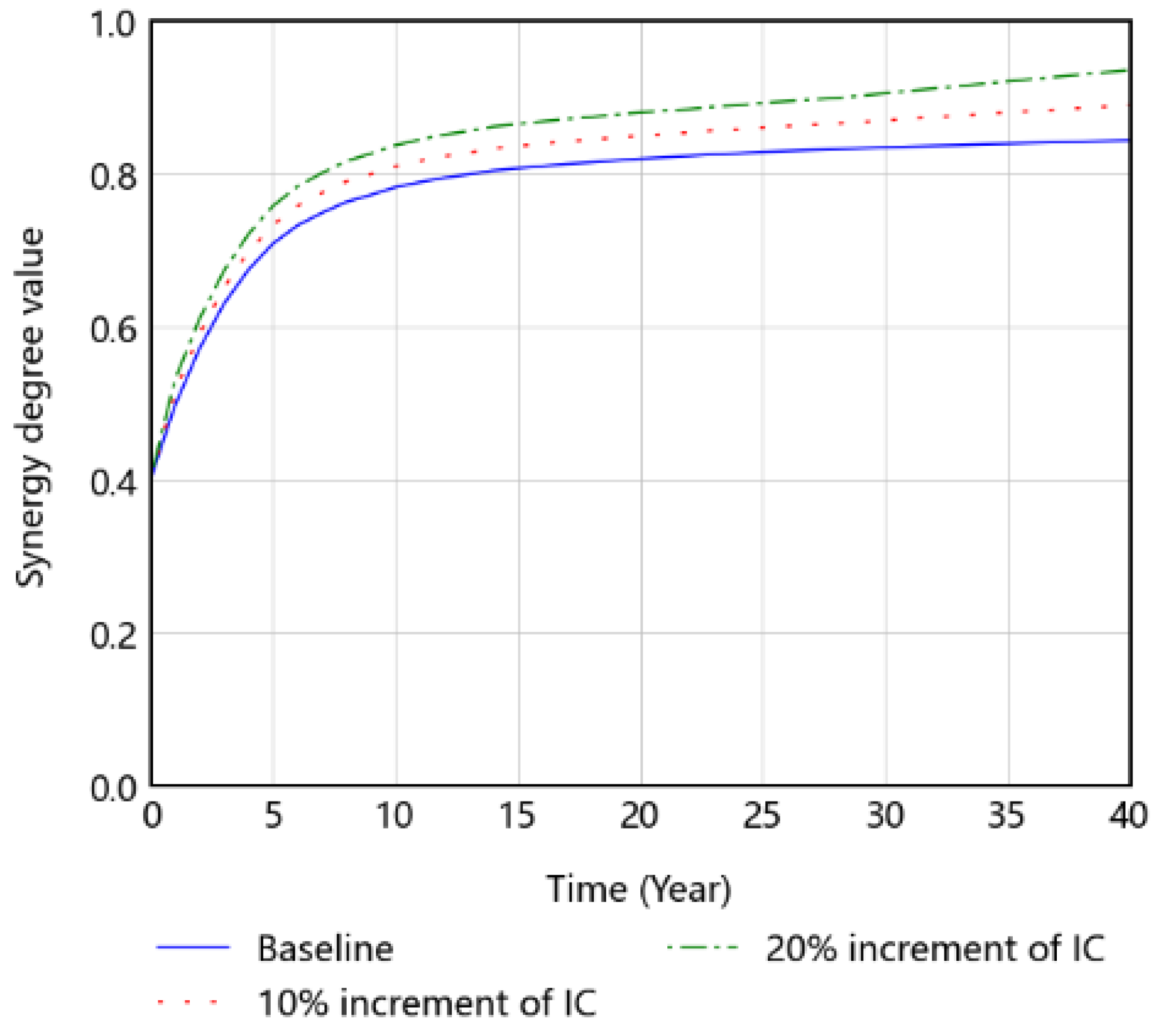
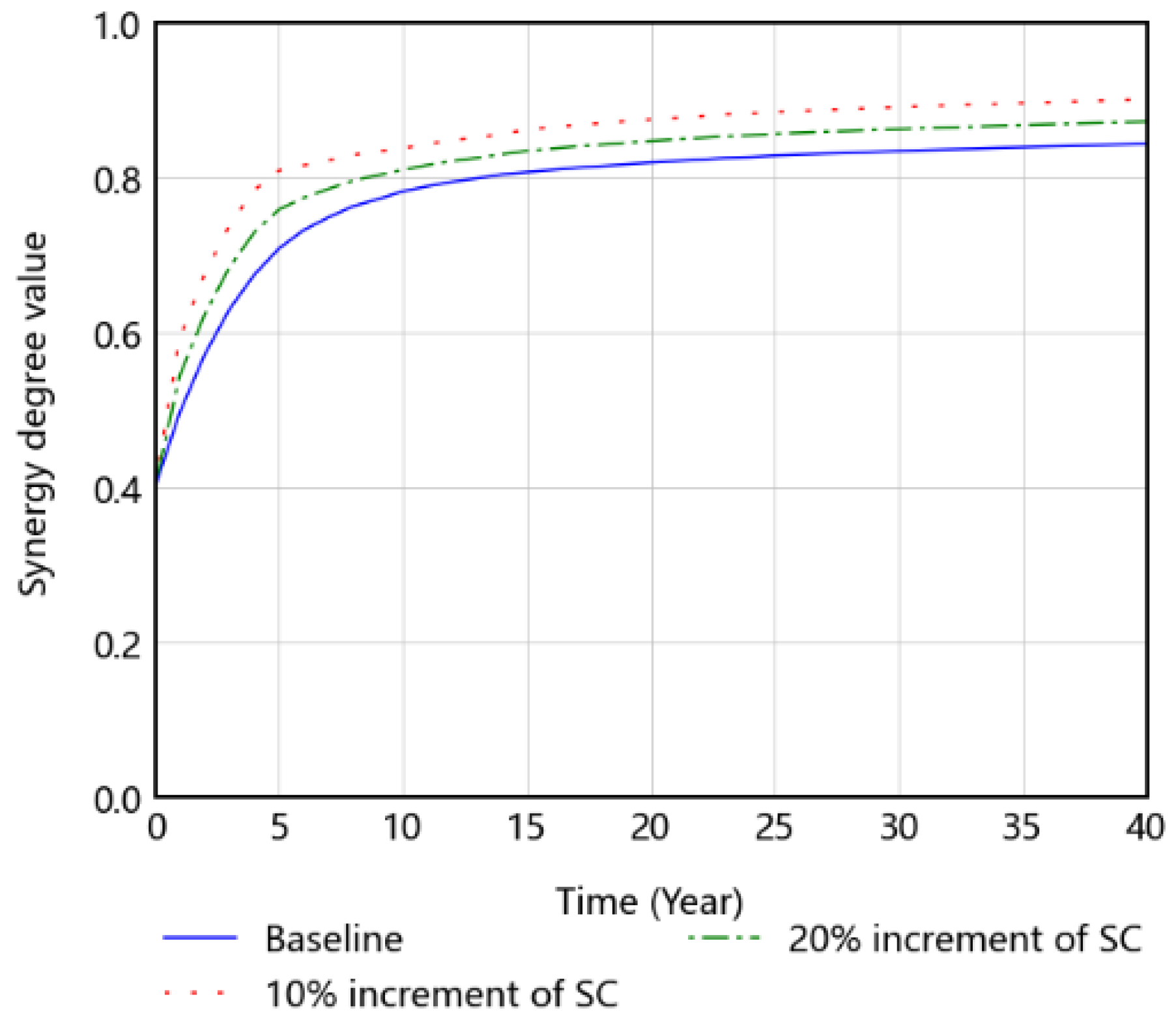
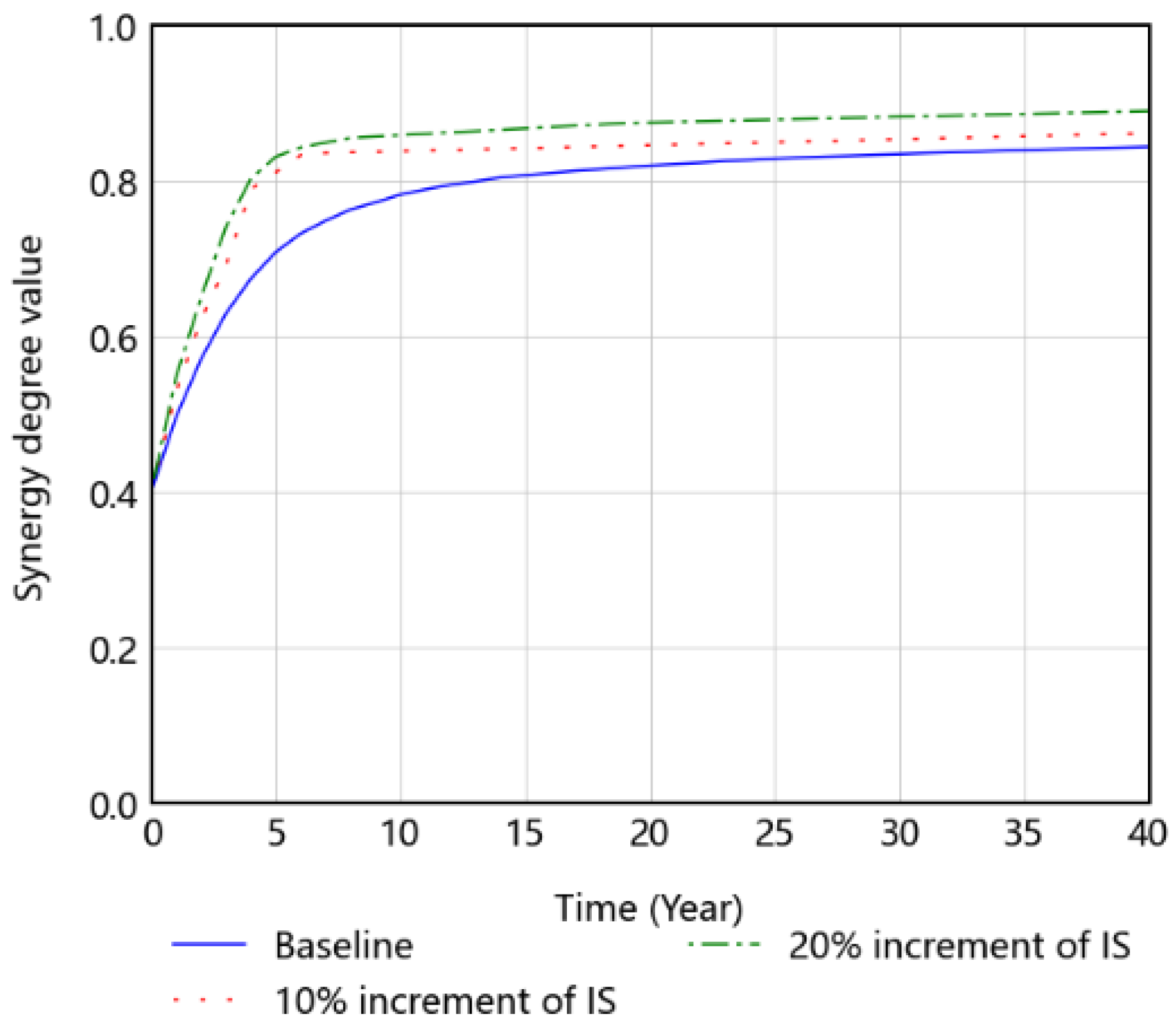
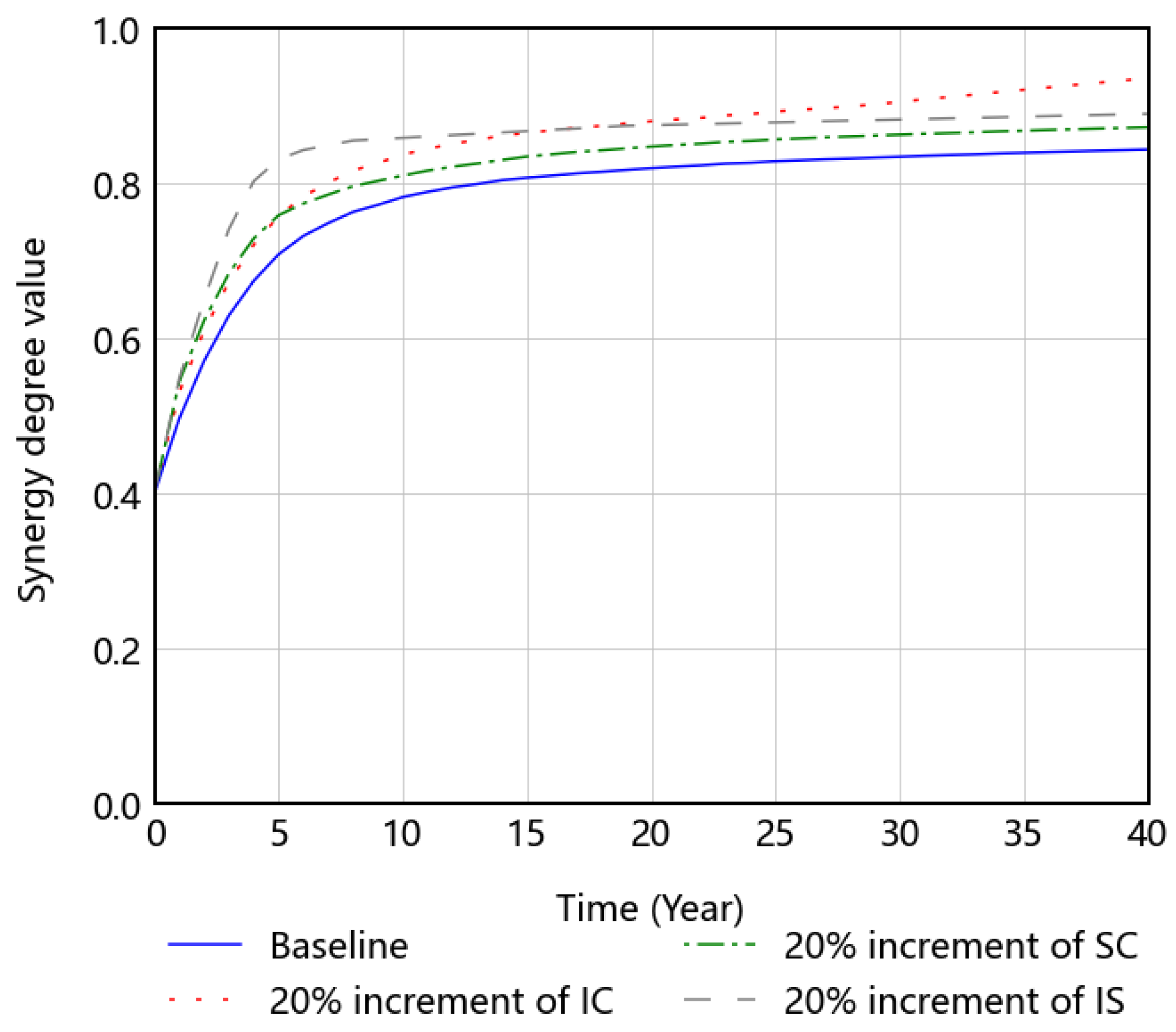
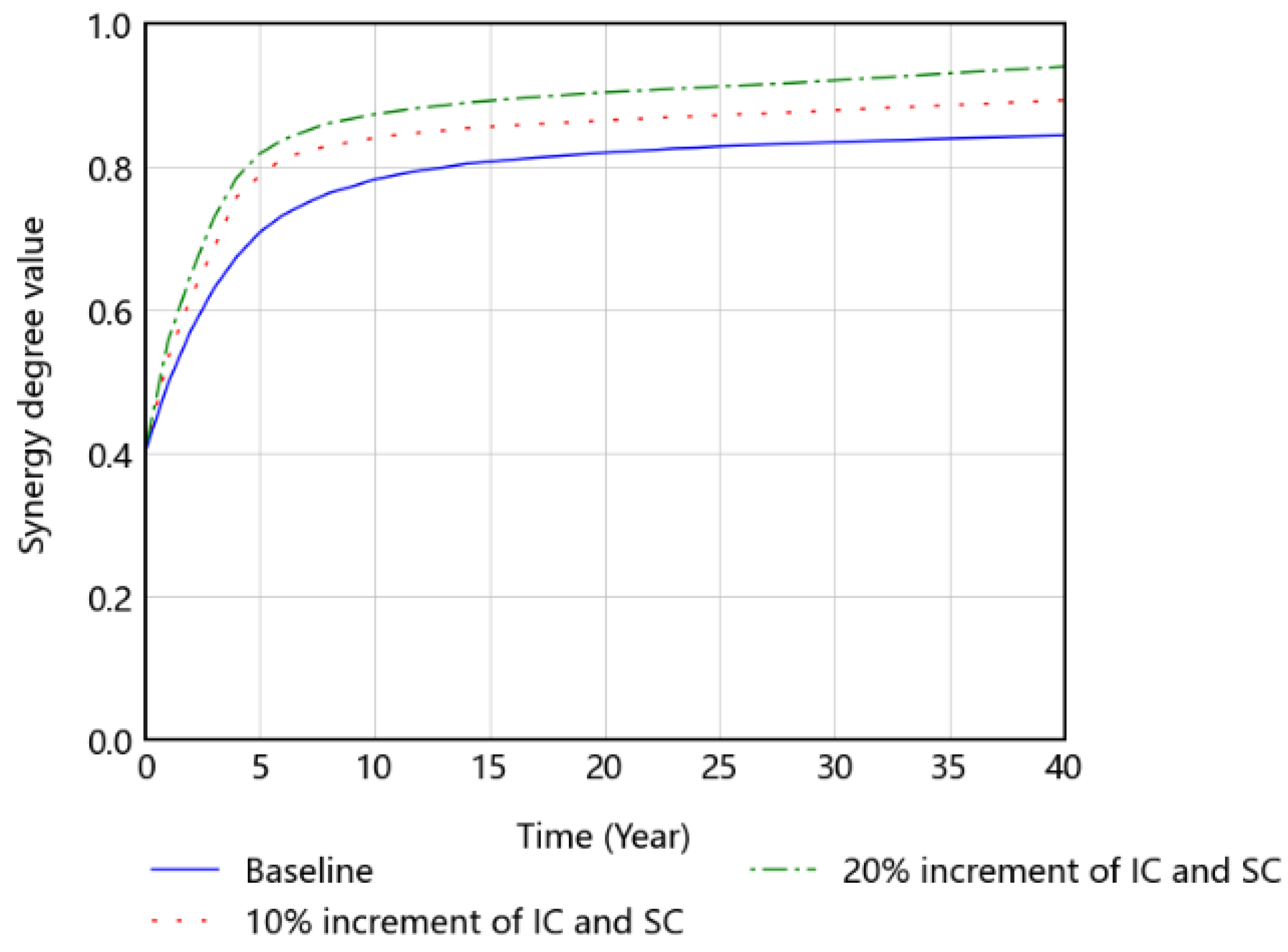

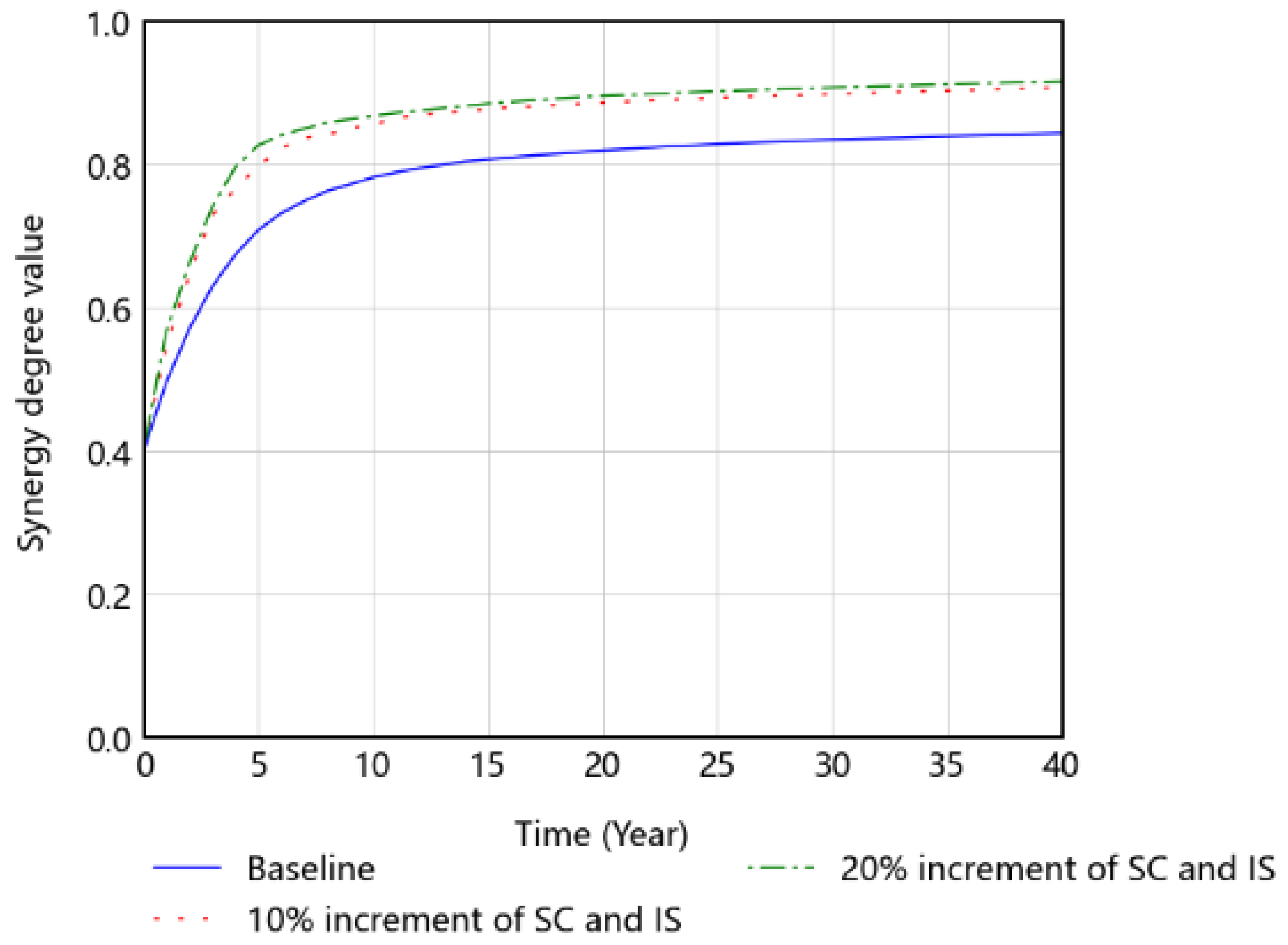
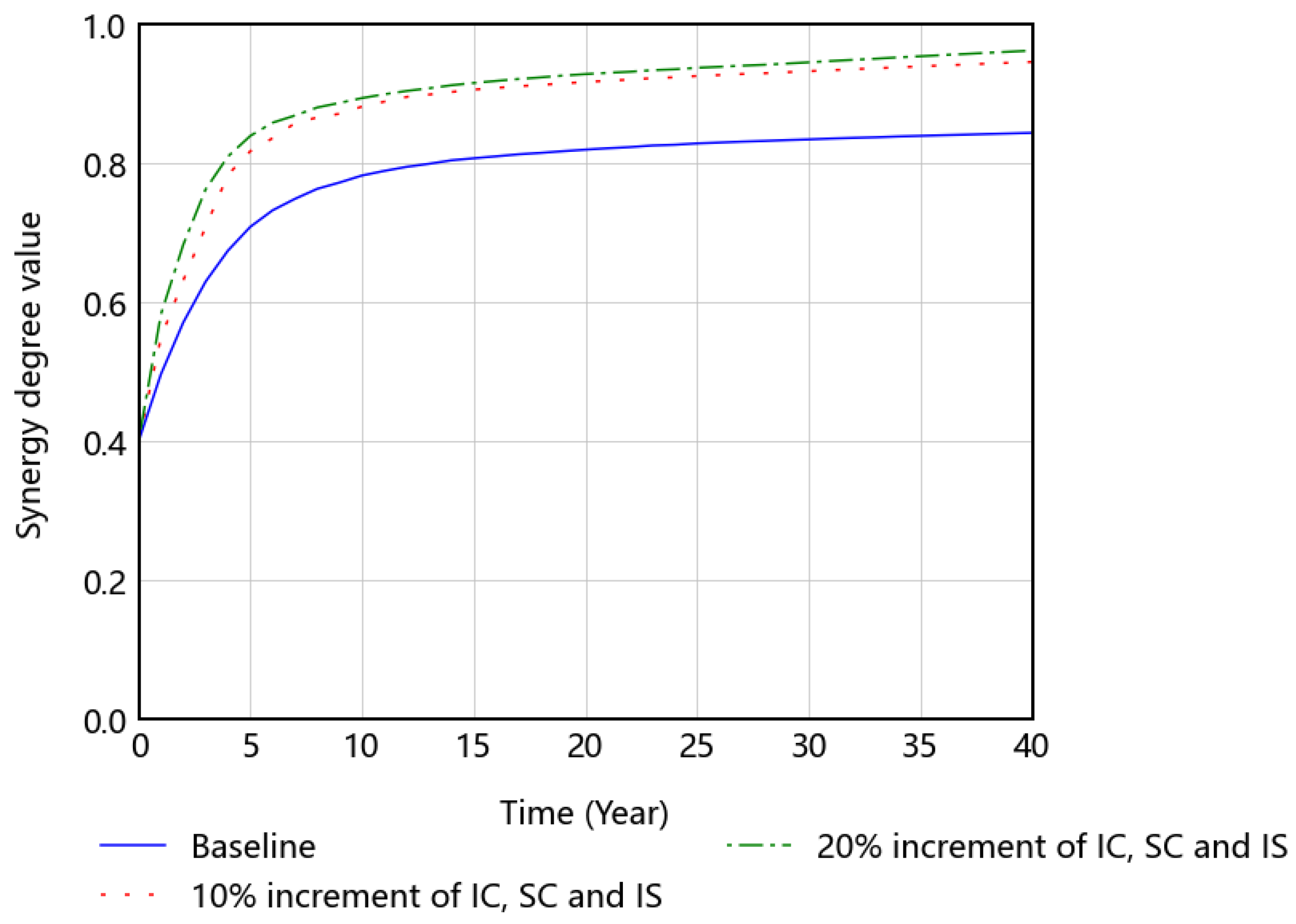
| Types | Code | Names | Description |
|---|---|---|---|
| Stock variables | IC | Institutional climate | The synergy degree of institutional climate of SO-CHECS controlled by variables of IC. |
| RA | Resource allocation | The synergy degree of resource allocation of SO-CHECS controlled by variables of RA. | |
| CM | Cooperation mechanism | The synergy degree of cooperation mechanism of SO-CHECS controlled by variables of CM. | |
| SE | Stakeholder engagement | The synergy degree of stakeholder engagement of SO-CHECS controlled by variables of SE. | |
| SC | Supervision capability | The synergy degree of supervision capability of SO-CHECS controlled by variables of SC. | |
| IS | Information sharing | The synergy degree of information sharing of SO-CHECS controlled by variables of IS. | |
| Flow variables | CIC | Changing of institutional climate | The rate of change in the synergy degree of institutional climate. |
| CRA | Changing of resource allocation | The rate of change in the synergy degree of resource allocation. | |
| CCM | Changing of cooperation mechanism | The rate of change in the synergy degree of cooperation mechanism. | |
| CSE | Changing of stakeholder engagement | The rate of change in the synergy degree of stakeholder engagement. | |
| CSC | Changing of supervision capability | The rate of change in the synergy degree of supervision capability. | |
| CIS | Changing of information sharing | The rate of change in the synergy degree of information sharing | |
| Auxiliary variables | SDV | Synergy degree value | The whole synergy of SO-CHECS consisting of the synergy of IC, RA, CM, SE, SC, and IS. |
| GS | Government guidance | The government guidance refers to the guide provided by the government to regulate the behaviors of social organizations. | |
| FSub | Funding subsidy | The funding subsidy is the degree to which SO-CHECS receives preferential conditions for the investment from government and is influenced by favorable policies. | |
| FP | Favorable policy | The favorable policy refers to preferential policies about financing and taxes from the government to reduce expenses, save costs, and motivate social organizations. | |
| MC | Market competition | The market competition is the number of rivals of social organizations who want to participate in CHECS. | |
| AF | Adequate facility | The adequate facility refers to the numbers and qualities of facilities for SO-CHECS. | |
| BD | Benefit distribution | The benefit distribution refers to the distribution of excess benefits among social organizations. The fair benefit distribution can improve CM. | |
| C | Collaboration | The collaboration is the model of collaboration between government, community, and social organizations. | |
| TM | Trust mechanism | The trust mechanism plays an important role in reducing transaction costs and disorders between different stakeholders. | |
| Spro | Service professionalization | The service professionalization refers to the professional degree of service provided by service staff. | |
| SI | Service informatization | The service informatization refers to the application of IT, such as IoT, cloud computing and big to provide convenient and efficient services for the elderly. | |
| SS | Service satisfaction | The service satisfaction is the degree of satisfaction of the elderly with the service. | |
| AS | Association supervision | The association of CHECS is responsible for setting standards and supervises the social organizations. | |
| MSP | Mutual supervision among all parties | The mutual supervision among all parties is based on the trust and cooperation and is good for the improvement of the quality of services. | |
| IB | Information breadth | The information breadth refers to the maximum extent of information flow in the process of information exchange and sharing between the social organizations. | |
| IC | Information accuracy | The information accuracy refers to the accurate degree of information communication and access. | |
| IZS | Informatization sensitivity | The informatization sensitivity refers to the timeliness of information exchange, sharing, and access. | |
| MC | Market access | The market access refers to the degree of rationalization of threshold set for the social organizations. | |
| PT | Professional training | The professional training refers to the professional degree of skills training for service workers. | |
| CT | Collaborative teamwork | The collaborative teamwork refers to the team collaboration of different professions. | |
| Constants | LR | Law and regulations | The law and regulations refer to the laws and regulations set for the development of SO-CHECS. |
| Fsou | Funding sources | The funding sources refer to the diversification of financing channels | |
| ISV | Information sharing value | The information sharing value is the value of information sharing to the social organizations. | |
| CPR | Clarified power and responsibility | The clarified power and responsibility refer to clearly defining the legal responsibilities of stakeholders. | |
| Sper | Service personalization | The service personalization refers to the service provided by social organizations that can meet the personal requirements of the elderly. | |
| PMS | Public and media supervision | The public and media supervision refers to unofficial public supervision in daily life, such social media in the network. |
| Indicator for Evaluation | R2 | RMSE |
|---|---|---|
| Synergy degree value | 0.868 | 0.137 |
Publisher’s Note: MDPI stays neutral with regard to jurisdictional claims in published maps and institutional affiliations. |
© 2022 by the authors. Licensee MDPI, Basel, Switzerland. This article is an open access article distributed under the terms and conditions of the Creative Commons Attribution (CC BY) license (https://creativecommons.org/licenses/by/4.0/).
Share and Cite
Shao, Q.; Ma, J.; Zhu, S. A System Dynamics Approach for Evaluating the Synergy Degree of Social Organizations Participating in Community and Home-Based Elderly Care Services. Buildings 2022, 12, 1491. https://doi.org/10.3390/buildings12091491
Shao Q, Ma J, Zhu S. A System Dynamics Approach for Evaluating the Synergy Degree of Social Organizations Participating in Community and Home-Based Elderly Care Services. Buildings. 2022; 12(9):1491. https://doi.org/10.3390/buildings12091491
Chicago/Turabian StyleShao, Qiuhu, Junwei Ma, and Shiyao Zhu. 2022. "A System Dynamics Approach for Evaluating the Synergy Degree of Social Organizations Participating in Community and Home-Based Elderly Care Services" Buildings 12, no. 9: 1491. https://doi.org/10.3390/buildings12091491
APA StyleShao, Q., Ma, J., & Zhu, S. (2022). A System Dynamics Approach for Evaluating the Synergy Degree of Social Organizations Participating in Community and Home-Based Elderly Care Services. Buildings, 12(9), 1491. https://doi.org/10.3390/buildings12091491





